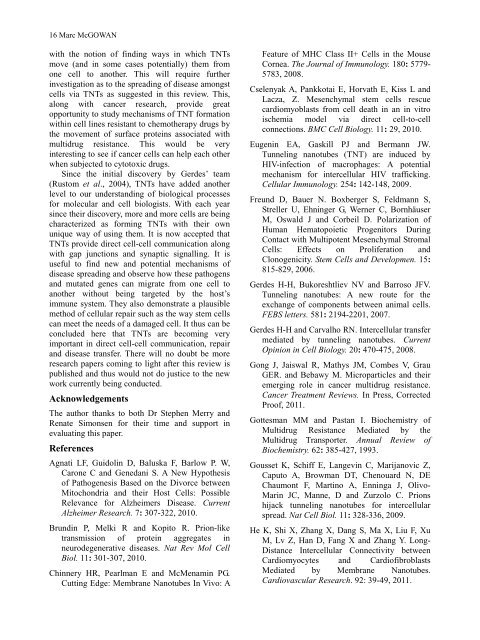Journal of Cell and Molecular Biology - ResearchGate
Journal of Cell and Molecular Biology - ResearchGate
Journal of Cell and Molecular Biology - ResearchGate
Create successful ePaper yourself
Turn your PDF publications into a flip-book with our unique Google optimized e-Paper software.
16 Marc McGOWAN<br />
with the notion <strong>of</strong> finding ways in which TNTs<br />
move (<strong>and</strong> in some cases potentially) them from<br />
one cell to another. This will require further<br />
investigation as to the spreading <strong>of</strong> disease amongst<br />
cells via TNTs as suggested in this review. This,<br />
along with cancer research, provide great<br />
opportunity to study mechanisms <strong>of</strong> TNT formation<br />
within cell lines resistant to chemotherapy drugs by<br />
the movement <strong>of</strong> surface proteins associated with<br />
multidrug resistance. This would be very<br />
interesting to see if cancer cells can help each other<br />
when subjected to cytotoxic drugs.<br />
Since the initial discovery by Gerdes’ team<br />
(Rustom et al., 2004), TNTs have added another<br />
level to our underst<strong>and</strong>ing <strong>of</strong> biological processes<br />
for molecular <strong>and</strong> cell biologists. With each year<br />
since their discovery, more <strong>and</strong> more cells are being<br />
characterized as forming TNTs with their own<br />
unique way <strong>of</strong> using them. It is now accepted that<br />
TNTs provide direct cell-cell communication along<br />
with gap junctions <strong>and</strong> synaptic signalling. It is<br />
useful to find new <strong>and</strong> potential mechanisms <strong>of</strong><br />
disease spreading <strong>and</strong> observe how these pathogens<br />
<strong>and</strong> mutated genes can migrate from one cell to<br />
another without being targeted by the host’s<br />
immune system. They also demonstrate a plausible<br />
method <strong>of</strong> cellular repair such as the way stem cells<br />
can meet the needs <strong>of</strong> a damaged cell. It thus can be<br />
concluded here that TNTs are becoming very<br />
important in direct cell-cell communication, repair<br />
<strong>and</strong> disease transfer. There will no doubt be more<br />
research papers coming to light after this review is<br />
published <strong>and</strong> thus would not do justice to the new<br />
work currently being conducted.<br />
Acknowledgements<br />
The author thanks to both Dr Stephen Merry <strong>and</strong><br />
Renate Simonsen for their time <strong>and</strong> support in<br />
evaluating this paper.<br />
References<br />
Agnati LF, Guidolin D, Baluska F, Barlow P. W,<br />
Carone C <strong>and</strong> Genedani S. A New Hypothesis<br />
<strong>of</strong> Pathogenesis Based on the Divorce between<br />
Mitochondria <strong>and</strong> their Host <strong>Cell</strong>s: Possible<br />
Relevance for Alzheimers Disease. Current<br />
Alzheimer Research. 7: 307-322, 2010.<br />
Brundin P, Melki R <strong>and</strong> Kopito R. Prion-like<br />
transmission <strong>of</strong> protein aggregates in<br />
neurodegenerative diseases. Nat Rev Mol <strong>Cell</strong><br />
Biol. 11: 301-307, 2010.<br />
Chinnery HR, Pearlman E <strong>and</strong> McMenamin PG.<br />
Cutting Edge: Membrane Nanotubes In Vivo: A<br />
<br />
Feature <strong>of</strong> MHC Class II+ <strong>Cell</strong>s in the Mouse<br />
Cornea. The <strong>Journal</strong> <strong>of</strong> Immunology. 180: 5779-<br />
5783, 2008.<br />
Cselenyak A, Pankkotai E, Horvath E, Kiss L <strong>and</strong><br />
Lacza, Z. Mesenchymal stem cells rescue<br />
cardiomyoblasts from cell death in an in vitro<br />
ischemia model via direct cell-to-cell<br />
connections. BMC <strong>Cell</strong> <strong>Biology</strong>. 11: 29, 2010.<br />
Eugenin EA, Gaskill PJ <strong>and</strong> Bermann JW.<br />
Tunneling nanotubes (TNT) are induced by<br />
HIV-infection <strong>of</strong> macrophages: A potential<br />
mechanism for intercellular HIV trafficking.<br />
<strong>Cell</strong>ular Immunology. 254: 142-148, 2009.<br />
Freund D, Bauer N. Boxberger S, Feldmann S,<br />
Streller U, Ehninger G, Werner C, Bornhäuser<br />
M, Oswald J <strong>and</strong> Corbeil D. Polarization <strong>of</strong><br />
Human Hematopoietic Progenitors During<br />
Contact with Multipotent Mesenchymal Stromal<br />
<strong>Cell</strong>s: Effects on Proliferation <strong>and</strong><br />
Clonogenicity. Stem <strong>Cell</strong>s <strong>and</strong> Developmen. 15:<br />
815-829, 2006.<br />
Gerdes H-H, Bukoreshtliev NV <strong>and</strong> Barroso JFV.<br />
Tunneling nanotubes: A new route for the<br />
exchange <strong>of</strong> components between animal cells.<br />
FEBS letters. 581: 2194-2201, 2007.<br />
Gerdes H-H <strong>and</strong> Carvalho RN. Intercellular transfer<br />
mediated by tunneling nanotubes. Current<br />
Opinion in <strong>Cell</strong> <strong>Biology</strong>. 20: 470-475, 2008.<br />
Gong J, Jaiswal R, Mathys JM, Combes V, Grau<br />
GER. <strong>and</strong> Bebawy M. Microparticles <strong>and</strong> their<br />
emerging role in cancer multidrug resistance.<br />
Cancer Treatment Reviews. In Press, Corrected<br />
Pro<strong>of</strong>, 2011.<br />
Gottesman MM <strong>and</strong> Pastan I. Biochemistry <strong>of</strong><br />
Multidrug Resistance Mediated by the<br />
Multidrug Transporter. Annual Review <strong>of</strong><br />
Biochemistry. 62: 385-427, 1993.<br />
Gousset K, Schiff E, Langevin C, Marijanovic Z,<br />
Caputo A, Browman DT, Chenouard N, DE<br />
Chaumont F, Martino A, Enninga J, Olivo-<br />
Marin JC, Manne, D <strong>and</strong> Zurzolo C. Prions<br />
hijack tunneling nanotubes for intercellular<br />
spread. Nat <strong>Cell</strong> Biol. 11: 328-336, 2009.<br />
He K, Shi X, Zhang X, Dang S, Ma X, Liu F, Xu<br />
M, Lv Z, Han D, Fang X <strong>and</strong> Zhang Y. Long-<br />
Distance Intercellular Connectivity between<br />
Cardiomyocytes <strong>and</strong> Cardi<strong>of</strong>ibroblasts<br />
Mediated by Membrane Nanotubes.<br />
Cardiovascular Research. 92: 39-49, 2011.

















